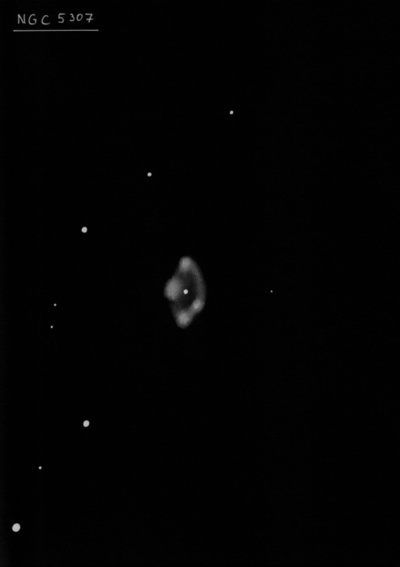
John Herschel discovered NGC 5307 = h3541 on 15 Apr 1836 and recorded "A very singular object. At first I thought it an ill seen double star; 12..13 = 12..13 mag; distance 2"; but not being able to get it into focus I applied 320 power; which showed it as a hazy, rather elongated, planetary nebulous disc, as if a double star all but obliterated. It is positively not a star. The field is full of stars, two of which are equal to this object in light, but 320 shows them both quite sharp. It is a difficult object to find, and unless in a good night for definition (this is superb) it could not be recovered. The place is well taken. It is the smallest and most difficult planetary nebula I have ever seen. Figure 15, plate VI, exhibits its appearance with power 320 (N.B. By this figure it would seem rather to belong to the class of double nebulae or double stellar nebulae of the utmost remoteness, than to that of planetary nebulae, properly so called.)"
Joseph Turner observed and sketched the planetary on 23 Jul 1875 with the Great Melbourne Telescope (unpublished Plate VII, figure 70). He noted a "bluish tinge" and commented that Herschel's sketch showed it as a double nebula (two condensations), but he couldn't see a duplex character, although it was elongated N-S (Herschel sketched it NW-SE).
200/250mm - 10" (6/29/02 - Bargo, Australia): at 214x and UHC filter, this small, fairly bright planetary appeared as a slightly elongated disc, ~13"x10" in diameter with a high, fairly even surface brightness except for a weak brightening at the center, but no definite central star. Set in a rich star field 45' ENE of globular NGC 5286 and mag 4.7 M Centauri.
400/500mm - 18" (7/5/05 - Magellan Observatory, Australia): fairly bright, small, blue-green oval, ~15"x10". This unusual planetary has an irregular, wispy surface brightness with fascinating glimpses of structure at 293x and 428x. It appears brighter along the major axis, particularly at the south end with a couple of small, darker areas or regions where the nebulosity is weaker on the sides. A trio of mag 13-14 stars to the southeast is collinear with the planetary. Situated in a fairly rich star field.
Notes by Steve Gottlieb